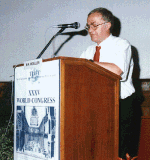 PREVALENCE OF DRUGS OF ABUSE AND MEDICATION IN CONSPICUOUS DRIVERS - AN EPIDEMIOLOGICAL STUDY
PREVALENCE OF DRUGS OF ABUSE AND MEDICATION IN CONSPICUOUS DRIVERS - AN EPIDEMIOLOGICAL STUDY
Moeller M.R., Hartung M.
Institute of Legal Medicine, University of Saarland, 66421 Homburg/Saar, Germany
In 1995, 4355 drivers in the state of Saarland suspected for DUI were made to give a blood sample. All of the samples were sent to the Institute of Legal Medicine for a determination of the blood-alcohol concentration (BAC). In order to study the epidemiology of drug use, we selected 632 of these samples; 286 by random selection, 243 from those drivers who were considered to have suspicuous symptomatology, but had a low BAC. In 103 of the samples, suspicion had previously been raised by the police concerning consumption of drugs of abuse or medication. These samples were examined for the most relevant substances of the present-day drug-scene in Germany.
We used GC or GC/MS to analyze these samples for cannabinoids, opiates, cocaine, amphetamines, ecstasy, benzodiazepines and barbiturates. Several substances underwent an initial immunological screening, whereas other drugs were directly analyzed by GC/MS after solid phase extraction.
In 192 samples we detected one or more of the screened drugs. 13.6 % of the random sample group and 28.4 % of the symptomatic sample group were positive for one or more drugs, but the cases with the highest percentage of positive results were in those drivers previously suspected by the police (81.6 %).
Of special interest is the increase in consumption of stimulants like cocaine, amphetamines and ecstasy in comparison to a similar epidemiologic study in 1990. Also of interest is the group of 15 ecstasy consumers which, as anticipated, comprise the youngest subjects with an average age of 23 years. In most of the consumers of this "designer-drug", the use of cannabis was also detected.
|